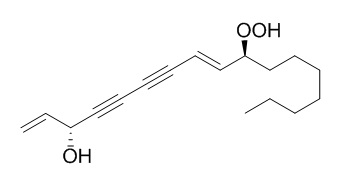Ginsenoyne K
Ginsenoyne K shows dose-dependent inhibitory effect on dopa oxidase activity of tyrosinase.
Inquire / Order:
manager@chemfaces.com
Technical Inquiries:
service@chemfaces.com
Tel:
+86-27-84237783
Fax:
+86-27-84254680
Address:
1 Building, No. 83, CheCheng Rd., Wuhan Economic and Technological Development Zone, Wuhan, Hubei 430056, PRC
Providing storage is as stated on the product vial and the vial is kept tightly sealed, the product can be stored for up to
24 months(2-8C).
Wherever possible, you should prepare and use solutions on the same day. However, if you need to make up stock solutions in advance, we recommend that you store the solution as aliquots in tightly sealed vials at -20C. Generally, these will be useable for up to two weeks. Before use, and prior to opening the vial we recommend that you allow your product to equilibrate to room temperature for at least 1 hour.
Need more advice on solubility, usage and handling? Please email to: service@chemfaces.com
The packaging of the product may have turned upside down during transportation, resulting in the natural compounds adhering to the neck or cap of the vial. take the vial out of its packaging and gently shake to let the compounds fall to the bottom of the vial. for liquid products, centrifuge at 200-500 RPM to gather the liquid at the bottom of the vial. try to avoid loss or contamination during handling.
Molecules.2024, 29(16):3976.
Curr Pharm Des.2024, 30(1):71-80.
Food Chem.2022, 378:131975.
Journal of Food and Drug Analysis2023, 31(3), 9.
Food Funct.2024, 15(8):4262-4275.
Food Science and Preservation2024, 31(3):486-498.
Expert Opin Ther Targets.2024, :1-11.
J Biomed Sci.2020, 27(1):60.
Agronomy2022, 12(10), 2426.
Phytomedicine.2018, 41:62-66
Related and Featured Products
Lobetyolinin
Catalog No: CFN92357
CAS No: 142451-48-7
Price: $318/10mg
Cordifolioidyne A
Catalog No: CFN95759
CAS No: 1004781-44-5
Price: $413/5mg
(3E,5E,11E)-tridecatriene-7,9-diyne-1,2-diacetate
Catalog No: CFN95191
CAS No: 94753-06-7
Price: $318/5mg
(Z)-Tonghaosu
Catalog No: CFN95633
CAS No: 4575-53-5
Price: $318/20mg
(E)-Tonghaosu
Catalog No: CFN95634
CAS No: 50257-98-2
Price: $318/20mg
11-Hydroxyjasmonic acid
Catalog No: CFN99457
CAS No: 140447-14-9
Price: Inquiry(manager@chemfaces.com)
12-Hydroxyjasmonic acid
Catalog No: CFN99460
CAS No: 140631-27-2
Price: Inquiry(manager@chemfaces.com)
(S,E)-Deca-2,9-diene-4,6-diyne-1,8-diol
Catalog No: CFN97501
CAS No: 931114-98-6
Price: Inquiry(manager@chemfaces.com)
(R,E)-Deca-2-ene-4,6-diyne-1,8-diol
Catalog No: CFN97502
CAS No: 931116-24-4
Price: Inquiry(manager@chemfaces.com)
Panaxydol
Catalog No: CFN92797
CAS No: 72800-72-7
Price: $448/20mg
J Agric Food Chem. 2008 May 14;56(9):3024-7.
Cytotoxic phenylpropanoids from carrot.[Pubmed:
18422328]
Carrot is widely used as a foodstuff. The active components such as beta-carotene and panaxynol have been studied by many researchers.
METHODS AND RESULTS:
In this investigation of nonpolar active components from carrot, a new phenylpropanoid, epilaserine oxide ( 3), was isolated along with six known compounds, laserine ( 1), 2-epilaserine ( 2), panaxynol ( 4), Ginsenoyne K ( 5), (8 E)-1,8-heptadecadiene-4,6-diyne-3,10-diol ( 6), and vaginatin ( 7). Their structures were deduced on the basis of spectroscopic methods. Significant cytotoxicity of 2-epilaserine against HL-60 cells was observed, which implied that phenylpropanoids were cytotoxic compounds in carrot.
CONCLUSIONS:
Laserine and 2-epilaserine in carrots from diverse locations in China were quantified by HPLC.
Natural Product Sciences, 2008 , 14 (3) :177-181.
Polyacetylenes from the tissue cultured adventitious roots of Panax ginseng C.A. meyer[Reference:
WebLink]
METHODS AND RESULTS:
Five polyacetylenes, Ginsenoyne K (1), (Z)-1-methoxyheptadeca-9-en-4,6-diyne-3-one (2), panaxydol (3), panaxydiol (4), and (E)-heptadeca-8-en-4,6-diyne-3,10-diol (5) were isolated from the adventitious roots of Panax ginseng and their chemical structures were elucidated by interpretation of spectroscopic data. Among the isolated compounds, compounds 2 and 5 were reported for the first time as a natural product.
CONCLUSIONS:
Ginsenoyne K (1) showed dose-dependent inhibitory effect on dopa oxidase activity of tyrosinase.



